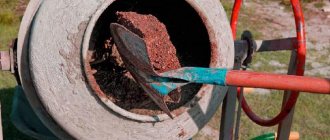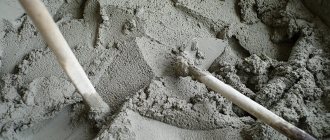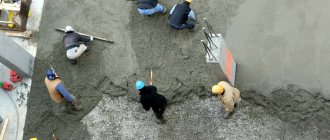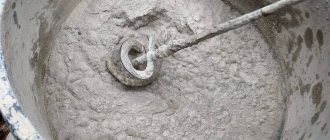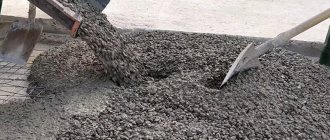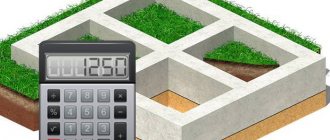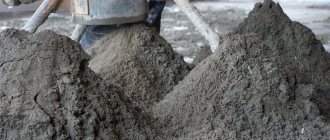In most cases, at private construction sites for pouring foundations or creating any other load-bearing structures, concrete production is practiced in a concrete mixer.
The task of making concrete can be handled either manually or by machine. It all depends on the amount of concrete needed. A concrete mixer is the most popular and affordable mechanized method of mixing concrete. Such machines can vary both in price and in size and quality. Of course, purchasing a concrete mixer for one use is at least wasteful. Therefore, it is more rational to rent a mixer.
The automated process allows you to achieve a better result, in which the strength of the solution doubles compared to manual mixing.
Main components and proportions of the mixture
- for M200 the proportions C:P:SH are 1:3:5;
- M300 - 1:2:3.5;
- M400 - 1:1,3:3;
- M450 - 1:1.1:2.5.
The volume of water consumed to prepare the mixture is determined from the ratio of 0.6-1.15 parts of water to 1 part of cement.
The higher the strength required, the less water is added. To mix concrete at the household level, the quantity of components is measured in buckets with a volume of 10-12 liters. For example, you can calculate the proportions of concrete components in buckets for pouring a foundation using the table.
Cement
Cement acts as the main binder in concrete and affects its physical properties. The role of the cement binder is to form a mortar matrix, which serves to evenly distribute the load between large and small filler particles.
The composition of cement includes:
To prepare concrete, cement grades from M200 to M500 (sometimes M600) are used. The numbers in the marking correspond to the minimum compressive strength in kg/cm 2 .
The quality of cement is determined by its shelf life. It is advisable that it be done no later than 3 months ago. When squeezed, it should not form lumps.
Crushed stone
Use crushed granite or gravel. It must be clean. Foreign objects and large pieces should be excluded.
Requirements for the size of granite crushed stone, depending on the purpose of using the solution:
- floor slabs - 5-10 mm;
- foundation for residential buildings - 5-20 mm, for industrial facilities - 20-40 mm;
Crushed gravel is used in the following fractional composition:
- construction and finishing works - 3-10 and 5-20 mm;
- foundation - 40-70 mm.
For the construction of private residential buildings, crushed stone with a particle size of 20-70 mm is usually used. It is introduced into concrete mortar as a coarse filler, which helps improve the strength characteristics of the mixture.
Sand
The purpose of using sand is to reduce cement consumption, fill pores between large fillers, and strengthen concrete.
The water for mixing concrete should not contain dissolved salts, alkalis, or acids. They prevent the mixture from setting and hardening properly. Water cannot be used:
- sewage;
- contaminated with harmful impurities;
- containing plant matter that may decompose;
- which contain oils and organic impurities.
Excipients
Auxiliary substances improve the properties of the concrete mixture. Add to the main ingredients:
If it is expected that the work will be carried out for a long time, substances are added that slow down the setting process.
Useful tips from an experienced builder
- To make cleaning the drum easier, you can lubricate the inside of the drum with mineral oil. Special oils are sold in hardware stores, but automotive oils can also be used.
- There are means not only to reduce the adhesion of the solution to the working surface, but to clean the drum and other parts from already set cement stone. Such protective agents are also applied to the inner surface of the drum once a day (before starting work).
- If the concrete mixer does not have the option of heating the mixture, such a concrete mixer can only operate at temperatures above +2*C.
How long does it take to mix concrete in a concrete mixer?
The time during which the solution must be mixed in a concrete mixer depends on its design and engine power. All these indicators are given in the operating instructions.
The duration of continuous operation without engine overload, depending on the type of concrete mixer, is:
- gravity - 2-2.5 minutes;
- forced type - 1-2 min.
Time is counted from the moment when all the ingredients have been loaded into the mixer drum. Prolonged mixing of concrete is not recommended. This is accompanied by evaporation of water and, accordingly, a decrease in its plasticity characteristics.
Cooking by hand
Preparation of concrete by hand. There are two types of manual kneading:
- Cement is added to a container with water in a certain proportion. The consistency is thoroughly mixed and filler and sand are poured into it. Mix the mixture thoroughly again until smooth;
- Dry ingredients are mixed in a container. A depression is created in the center into which water is poured. Mixing occurs gradually from the edges to the center. It is necessary to constantly monitor the plasticity of the mixture by adding water.
The procedure goes as follows:
- pour the required amount of sand into a metal box or onto tin sheets 2x2 m;
- add the required volume of Portland cement depending on the brand of concrete and its purpose;
- after thoroughly mixing the components, add water and filler depending on the proportions drawn up for a specific construction;
- Repeated mixing with a shovel until the resulting mixture reaches a uniform consistency and is free of lumps.
Main components of the mixture
High-quality material that meets all requirements can only be obtained if all technological conditions have been met and the proportions of the components have been correctly calculated.
The composition of the mixture may differ by brand depending on additional additives, with the help of which concrete can perform additional functions (increased frost resistance, plasticity, etc.). The standard recipe includes:
- cement;
- sand;
- crushed stone;
- water.
What mistakes are made when independently preparing material?
- Save on crushed stone, sand, plasticizers.
In this case, the concrete will turn out to be liquid, will harden for a long time and will shrink in 2-3 weeks. It will also lose strength and resistance to low air temperatures and moisture. - Clay getting into sand.
This component reduces the adhesion of the material, and cracks appear on it after a couple of months. - Too much water.
The mixture will turn out to be too liquid, it will harden for a long time, and then pores will appear in it, affecting the strength of the foundation, floor, and walls. - “Undermixed” components.
If you do not mix the dry substances well, the concrete will not be dense and will take longer to harden. - A mixture of water and plasticizers.
By combining these two components, you will end up with lumps in the mixture that cannot be removed. The quality of the material will decrease.
The ratio of components in concrete
| Brand and class | Ratio, kg | Concrete yield from a cement bucket, l | ||
| cement | sand | crushed stone | ||
| M100 V7.5 | 1 | 4,6 | 7 | 78 |
| M150 V12.5 | 1 | 3,5 | 5,7 | 64 |
| M200 B15 | 1 | 2,8 | 4,8 | 54 |
| M250 B20 | 1 | 2,1 | 3,9 | 43 |
| M300 V22.5 | 1 | 1,9 | 3,7 | 41 |
| M350 B25 | 1 | 1,6 | 2,7 | 38 |
| M400 B30 | 1 | 1,2 | 2,7 | 31 |
| M450 B35 | 1 | 1,1 | 2,5 | 29 |
Kawabanga!
How to clean a concrete mixer from hardened cement Proportions of concrete in buckets
When preparing the mixture in a concrete mixer with your own hands, use a 10-liter bucket, which serves as a convenient measuring container.
| Brand and class | Cement in bags of 50 kg, pcs. | Proportions in buckets | ||
| Sand | Crushed stone | water | ||
| M200 B15 | 1 | 6 | 14 | 4 |
| M250 B20 | 1 | 5 | 12 | 3,5 |
All components occupy different volumetric masses in the bucket: cement - 15 kg, sand - 19 kg, crushed stone - 17.5 kg.
Proportions of ASG and cement when preparing concrete
Sand and gravel mixtures are often used as solid aggregate. Based on the percentage of gravel in their composition, they are divided into 2 groups:
- PGS (natural) – 10-20%;
- OPGS (sorted) – 15-75%.
For work requiring increased strength of building structures, bulk mixtures of sand and gravel of sea or river origin are used.
| Concrete grade | Proportions, kg | Ratio, l | ||
| PGS | Cement M400 | PGS | Cement M400 | |
| 100 | 1 | 11,6 | 10 | 102 |
| 150 | 1 | 9,2 | 10 | 82 |
| 200 | 1 | 7,6 | 10 | 67 |
| 250 | 1 | 6 | 10 | 53 |
| 300 | 1 | 5,6 | 10 | 49 |
| 400 | 1 | 3,9 | 10 | 35 |
| 500 | 1 | 3,6 | 10 | 32 |
Tips and tricks for making concrete in a concrete mixer
1. When purchasing cement, always pay attention to the production date, since its activity decreases over time. When clenched into a fist, fresh powder easily spills through your fingers, and old powder turns into a lump.
2. It is best to choose river sand with a fraction of 1.5-5 mm. It is well washed and does not contain impurities (unlike quarry).
3. When making durable concrete, it is better to choose gravel (or crushed stone) with particles of different fractions as a solid aggregate. This ensures their tight fit and the absence of large voids.
4. It is convenient to store dry aggregates (sand, gravel, crushed stone) in bulk next to the concrete mixer. It is better to lay a tarpaulin or thick oilcloth underneath. If bulk materials are simply laid on the ground, then it is not recommended to use lower layers.
5. The concrete mixture hardens quickly. Therefore, after preparation, it must be used within half an hour. The hardened composition should not be diluted with water - this will impair its quality.
6. If the proportions of water are violated, the solution may turn out to be too liquid and fragile. After drying, cracks appear on it. Ideal home-made concrete has the consistency of curd mass.
7. If production takes place in frosty weather, then it is better to heat the water.
Recommendations for mixing the solution
Each master will certainly give you his recommendations if you ask him. And I will give too, even if you don't ask. And if you don’t ask anyone and no one gives you sensible advice, then how can you make concrete?
- Before starting work, be sure to check the equipment for operability, turn it at idle, listen to how the engine works. Inspect the electrical cable for damage. Wipe off protective lubricant if the machine is new.
- Be sure to place the concrete mixer on a level surface. It would be correct to place some kind of shield and check the horizontal level. Make sure there is no distortion. This can create vibration and, as a result, increased load on the engine, which can even lead to engine failure.
- If you are unsure of the recipe, do a test batch first. Let it be half of the whole portion. If you are a beginner and it seems to you that the solution is a little dry, do not rush to add water. Concrete that is too wet will separate into fractions and its quality will deteriorate significantly. It can also crack when shrinking. Add water in small portions and observe. Better yet, buy a plasticizer. Its consumption is only 50 g. for 1 bucket of cement.
- Do not start the machine with material loaded. Correctly, first turn it on and only then start adding ingredients.
- How to determine that the solution is ready? Unload some of the compound and make notches with a trowel. The solution should hold its shape and the ridges should not blur. The cement mixture itself must be evenly mixed, smooth and plastic.
- To prevent the solution from sticking to the walls, it is recommended to pour 1 bucket of gravel after loading water and cement. The stones will allow you to mix the cement evenly and remove the adhering layer from the walls and blades.
- Do not forget to rinse the container with water after each batch. Pour 1 bucket and swirl for a few seconds. This water can then be used for a new batch of concrete.
- If sand and cement stick to the inside of the tank, this can reduce the content of these components in the finished solution. "Underweight" can affect the quality of concrete. Therefore, either do not allow sticking, or add 10% more of these components.
- If it happens that the concrete has dried up, use drastic measures (but do not abuse it, otherwise you will break the device). Throw broken bricks into the tank and swirl until the container is clean. Then shake it all out of the drum and rinse it with water.
- Don't forget to wash the outside of your car. It will be nice for you and others will see what a caring owner you are.
Operating principle and advantages
I think you already understand how concrete mixers work and how to mix concrete in them. Let's summarize:
- in some, only the blades rotate, and the drum itself is motionless (forced type of machines);
- and for others, the drum itself rotates on which the blades are mounted (these are gravitational mixers).
Next I will describe the advantages of each type of mixers. For convenience, we will make a table.
If there is a question of quality and you need to mix a lot of cement, think about a forced aggregate. In this case, a machine with a vertical shaft is recommended; it has fewer problems with unloading the solution.
Do-it-yourself assembly sequence
To work, you will need tools such as pliers, wrenches, a drill, an angle grinder with metal discs and a welding machine. The standard scheme of a forced-action mortar mixer includes the following elements:
The recommended assembly order in this case includes the following steps:
2. Welding the frame. The simplest frame is two triangles on the sides of the structure. It should be noted that even the smallest concrete mixer will weigh about 200 kg; for ease of movement, wheels are attached to one edge.
Proportions of components and operating procedure
It seems that the components have been sorted out. Now it’s time for their number. That is, we will find out what rules and proportions must be observed to prepare concrete for one purpose or another.
First, I will say (or remind you) that concrete is divided into grades based on strength. And each type of strength is used for specific purposes.
The average proportions of concrete in parts look like this: 1:3:5. This means that for 1 part of cement there are 3 parts of sand and 5 parts of crushed stone. Practical builders say that it is more reliable to use the formula 1:2:4.
The proportions of substances for the foundation consist of the following ratio: 8 parts OPGS, 1 part Portland cement, 0.5 parts water. By the way, you can measure proportions in shovels or buckets.
Please note that at one time in a concrete mixer you can mix a solution with a volume of 2/3 of the total size of the tank:
- In a 160 liter concrete mixer you can make 120 liters of solution at a time.
- For a concrete mixer of 180 liters, you need to calculate the number of components so that the total volume does not exceed 140 liters.
If you count in buckets, then for 1 batch in concrete containers with a volume of 150-180 liters you need to put 1 bucket of cement, 2 buckets of sand, 4 buckets of gravel and half a bucket of water.
To avoid overdoing it with water, do a test batch. Do not pour all the water at once. Pour in 2/3 of the intended volume and then gradually add as needed. This way you can choose the optimal quantity.
If you have read the instructions for mixers, then you know that it describes the operating procedure and the sequence of laying out the components. Don't ignore this point, it's really very important.
In general, before starting work, if the machine is completely new or has been idle for a long time, carry out preparations. Check the lubrication on the mechanical elements, turn the mechanism at idle, make sure there are no extraneous sounds.
The loading order itself looks like this:
Wait 1-2 minutes between loading components.
What to look for when choosing a concrete mixer
When selecting a concrete mixer, you should first decide on the size. If you are taking on a large project, you will need a lot of concrete, so it is worth finding a concrete mixer that can mix a large amount of concrete at once, which will make your job much easier and save time.
Volumetric concrete mixers, as a rule, run on diesel fuel and are mounted on wheels to facilitate movement around the site. Some models can mix up to 110 liters in just six minutes.
For simple to moderately complex projects, you should choose an inclined concrete mixer. They are not as large as bulk concrete mixers, but are still capable of mixing quite a lot of concrete. Once the concrete is ready, you can easily tilt the mixer and pour it into the wheelbarrow.
Make sure to choose a concrete mixer that is safe enough and easy to use. Consider the complexity and scope of the project, uneven terrain and obstacles, and the size of the work area.
How much concrete can you mix with a concrete mixer in a day?
How many? Controversial issue. Because it may even depend on your mood. But suppose you are ready to work all day without a break. Let's see what else the yield of a useful product depends on and calculate:
- Depending on the volume of the pear (sometimes 45, 60, 120, 160, 180 l).
- Engine power (that is, how quickly the machine mixes one portion and how long it can work without interruption).
- Human factor (how quickly the mixture is loaded and unloaded).
Kawabanga! How to prepare concrete: requirements for materials, proportions and calculation of composition
There is a simple calculation algorithm. If you're interested, you can do the math. To do this you need the following numbers:
Now we calculate: we multiply the time that you are ready to work by “the amount of concrete produced in 1 hour.” So how? On average it should be 3 cubic meters per day.
Other options
If you understand that you will not be able to prepare the foundation for pouring the foundation of a frame house or other small structures with your own hands, then seek the help of professionals.
Without racking your brains over how many components to take and how to mix them, you can buy a cube of concrete, which should be enough for a small construction project.
A cube of this construction product costs from 2,400 rubles. This figure applies to the lowest grade. A medium-strength cube (M400) costs from 3,200 rubles. The most expensive and reliable brand is M600.
A cube of such concrete will cost 4 thousand.
During any construction work, it is necessary to adhere to a certain procedure in order for the result to be of the highest quality. The exact order in which the concrete mixer is loaded is one of the most important factors on which the final quality of the solution depends.
A concrete mixer is a construction equipment designed to prepare a homogeneous concrete mixture.
Forced action concrete mixer and gravity unit
There are no fundamental differences in the order of mixing the solution in these machines. The only difference is in the operating principle of the units. The forced one actively mixes with blades, and the gravitational one uses the rotation of the drum itself and the force of universal gravity.
The main thing here is to take the right time. The forced one does its job 2 times faster.
The forced-type concrete mixer has different sizes and modifications:
- rotary;
- cascade:
- planetary.
Truck-mounted concrete mixers
Very often situations arise when a significant volume of concrete is needed in a certain but short time, and there is no mortar unit nearby. The best way out in this situation is to use a concrete mixer. These are concrete mixers mounted on a car chassis. They are driven by a car engine. True, there are concrete mixers driven by other engines, then such an installation is called autonomous. An autonomous installation seems to be preferable; in the event of a car engine breakdown, the drum will not stop and the concrete will not “set”, but it is much noisier and more energy-intensive.
Concrete mixers used in the post-Soviet space have a drum volume of 2-10 m3. The drum can rotate in any direction. Inside it, blades are installed at a certain angle. When the car moves, the blades rotate in such a direction that the ingredients and water are driven inside the drum and mixed by the blades. When unloading, the drum is launched in the other direction, and these same blades, moving in the opposite direction, push out the concrete.
The ratio of components in concrete
| Brand and class | Ratio, kg | Concrete yield from a cement bucket, l | ||
| cement | sand | crushed stone | ||
| M100 V7.5 | 1 | 4,6 | 7 | 78 |
| M150 V12.5 | 1 | 3,5 | 5,7 | 64 |
| M200 B15 | 1 | 2,8 | 4,8 | 54 |
| M250 B20 | 1 | 2,1 | 3,9 | 43 |
| M300 V22.5 | 1 | 1,9 | 3,7 | 41 |
| M350 B25 | 1 | 1,6 | 2,7 | 38 |
| M400 B30 | 1 | 1,2 | 2,7 | 31 |
| M450 B35 | 1 | 1,1 | 2,5 | 29 |
Proportions of concrete in buckets
When preparing the mixture in a concrete mixer with your own hands, use a 10-liter bucket, which serves as a convenient measuring container.
| Brand and class | Cement in bags of 50 kg, pcs. | Proportions in buckets | ||
| Sand | Crushed stone | water | ||
| M200 B15 | 1 | 6 | 14 | 4 |
| M250 B20 | 1 | 5 | 12 | 3,5 |
All components occupy different volumetric masses in the bucket: cement - 15 kg, sand - 19 kg, crushed stone - 17.5 kg.
Proportions of ASG and cement when preparing concrete
Sand and gravel mixtures are often used as solid aggregate. Based on the percentage of gravel in their composition, they are divided into 2 groups:
- PGS (natural) – 10-20%;
- OPGS (sorted) – 15-75%.
For work requiring increased strength of building structures, bulk mixtures of sand and gravel of sea or river origin are used.
| Concrete grade | Proportions, kg | Ratio, l | ||
| PGS | Cement M400 | PGS | Cement M400 | |
| 100 | 1 | 11,6 | 10 | 102 |
| 150 | 1 | 9,2 | 10 | 82 |
| 200 | 1 | 7,6 | 10 | 67 |
| 250 | 1 | 6 | 10 | 53 |
| 300 | 1 | 5,6 | 10 | 49 |
| 400 | 1 | 3,9 | 10 | 35 |
| 500 | 1 | 3,6 | 10 | 32 |
Tips and tricks for making concrete in a concrete mixer
1. When purchasing cement, always pay attention to the production date, since its activity decreases over time. When clenched into a fist, fresh powder easily spills through your fingers, and old powder turns into a lump.
2. It is best to choose river sand with a fraction of 1.5-5 mm. It is well washed and does not contain impurities (unlike quarry).
3. When making durable concrete, it is better to choose gravel (or crushed stone) with particles of different fractions as a solid aggregate. This ensures their tight fit and the absence of large voids.
4. It is convenient to store dry aggregates (sand, gravel, crushed stone) in bulk next to the concrete mixer. It is better to lay a tarpaulin or thick oilcloth underneath. If bulk materials are simply laid on the ground, then it is not recommended to use lower layers.
5. The concrete mixture hardens quickly. Therefore, after preparation, it must be used within half an hour. The hardened composition should not be diluted with water - this will impair its quality.
6. If the proportions of water are violated, the solution may turn out to be too liquid and fragile. After drying, cracks appear on it. Ideal home-made concrete has the consistency of curd mass.
7. If production takes place in frosty weather, then it is better to heat the water.
A concrete mixer is a construction equipment designed to prepare a homogeneous concrete mixture.
First you need to differentiate between concrete and cement, because... They are used for completely different needs. Their structural component differs only in the presence of crushed stone (there is none in cement), but in practice there are differences.
Concrete is necessary when pouring foundations, columns and other elements more than 2 cm in thickness.
Brand - load-bearing capacity in the ratio kgcm², i.e. M300 means that 1 cm² can support up to 300 kg.
The composition includes up to 4 components: cement, sand, gravel and water, and many companies sell sand and gravel mixture (SGM), which is immediately mixed in the optimal ratio. Sand and cement must be washed before use.
Table of application of cement mortars.
Sand is the main impurity, and its granules come in different sizes, which significantly affects the final result. Large sand granules can partially compensate for cement, but not more than 7-10%, so you cannot rely on this factor.
Kawabanga! Methods for determining the strength of concrete
Gravel is a coarse aggregate that directly affects strength properties, as well as the consumed volume of other additives. Necessary for pouring massive durable products.
Water - only drinking water is used, without garbage, so as not to harm the solution. Usually required in small quantities.
Return to contents
Mixing options and order
Proportions of concrete components.
If it is not concrete that is being prepared, but cement, then the ratio of sand, cement and water will be 2:1:0.8.
But the industrial version is much more complicated, because... requires more precision:
It is worth remembering that even in those places where high quality results are not required (M100 is enough), it is better to overpay a little, but make the most durable design possible.
It is thanks to the high grade and durable construction that the foundations can withstand the pressure of heaving soils, seasonal frosts, flooding and other adversities.
How to properly mix concrete in a concrete mixer - step-by-step diagram
Step 1: Installation of concrete mixer
Step 2: Download Components
Step 3: Mixing
Step 4: Unloading concrete and cleaning the unit
- Author: Manager Andrey
(7 votes, average: 4.3 out of 5)
To solve this problem, there are special counting methods. We will turn to them.
The most common grades of cement are M400 and M500. Sand is best used with grains no larger than 2.5 mm in diameter. Crushed stone is used in fractions of 5-20 mm.
For the above parameters we will provide the necessary numbers.
Number of components for preparing a cubic meter of concrete
So, the following amount of materials will be required. If you use M400 cement, then for 1m3 of concrete you need:
- 338 kg cement
- 642 kg sand
- 1250 kg crushed stone
- 170 l water
If the cement is grade M500, then you will need:
- 292 kg cement
- 702 kg sand
- 1258 kg crushed stone
- 146 liters of water
After translation, the following values were obtained.
When using M400 cement you need:
- 281 liters of cement
- 445 l sand
- 781 l crushed stone
When using cement M500 it is necessary:
- 243 liters of cement
- 487 l sand
- 786 l crushed stone
Number of components for volume-specific concrete mixers in buckets
70 l concrete mixer
For cement M400:
- Cement - 1.1
- Sand - 1.8
- Crushed stone - 3.1
- Water - 0.7
For cement M500
- Cement - 1
- Sand - 2
- Crushed stone - 3.1
- Water - 0.6
Concrete mixer 100 l
For cement M400:
- Cement - 1.5
- Sand - 2.5
- Crushed stone - 4.3
- Water - 1
For cement M500
- Cement - 1.3
- Sand - 2.7
- Crushed stone - 4.3
- Water - 0.8
Concrete mixer 120 l
For cement M400:
- Cement - 1.8
- Sand - 3
- Crushed stone - 5
- Water - 1.1
For cement M500
- Cement - 1.6
- Sand - 3.2
- Crushed stone - 5
- Water - 1
Concrete mixer 140 l
For cement M400:
- Cement - 2.2
- Sand - 3.5
- Crushed stone - 6
- Water - 1.3
For cement M500
- Cement - 1.8
- Sand - 3.7
- Crushed stone - 6
- Water - 1.1
Concrete mixer 160 l
For cement M400:
- Cement - 2.5
- Sand - 4
- Crushed stone - 7
- Water - 1.5
For cement M500
- Cement - 2.1
- Sand - 4.3
- Crushed stone - 7
- Water - 1.3
Concrete mixer 180 l
For cement M400:
- Cement - 2.8
- Sand - 4.5
- Crushed stone - 7.7
- Water - 1.7
For cement M500
- Cement - 2.5
- Sand - 4.8
- Crushed stone - 7.8
- Water - 1.5
Concrete mixer 200 l
For cement M400:
- Cement - 3
- Sand – 5
- Crushed stone - 8.5
- Water - 1.9
For cement M500
- Cement - 2.7
- Sand - 5.5
- Crushed stone - 8.7
- Water - 1.6
Concrete mixer 220 l
For cement M400:
- Cement - 3.5
- Sand - 5.3
- Crushed stone - 9.5
- Water - 2
For cement M500
- Cement - 3
- Sand - 6
- Crushed stone - 9.5
- Water - 1.8
Concrete mixer 250 l
For cement M400:
- Cement - 3.8
- Sand - 6.1
- Crushed stone - 10.7
- Water - 2.3
For cement M500
- Cement - 3.3
- Sand - 6.7
- Crushed stone - 10.8
- Water - 2
How to create a forced concrete mixer with your own hands?
In order to make a forced concrete mixer yourself, you must first understand what exactly is included in the standard package of this device. As a rule, a standard construction mixer of this type consists of:
Required materials and tools
Having decided on the required elements of a forced mixer, it is necessary to prepare the tools and materials from which, in fact, the device will be created. To do this you will need the following parts:
It is also very important that during the assembly of the concrete mixer you have on hand the following tools:
- pliers;
- Bulgarian;
- adjustable wrenches and wrenches;
- drill with different attachments;
- welding machine.
How to collect?
The process of assembling a forced concrete mixer - if you have certain skills - takes very little time if you carry out the work in stages:
